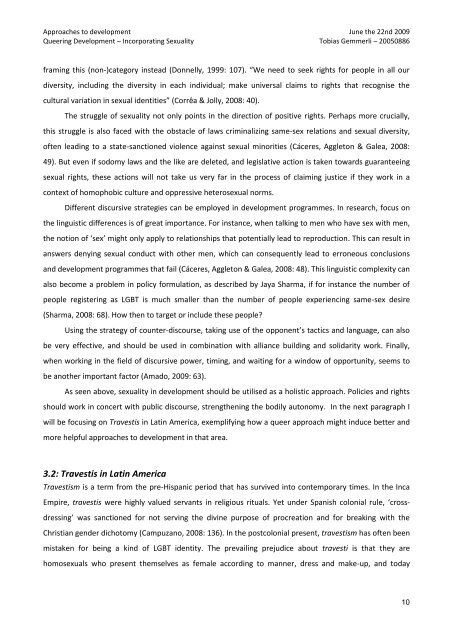Queering Development - Incorporating Sexuality - The problem of ...
Queering Development - Incorporating Sexuality - The problem of ...
Queering Development - Incorporating Sexuality - The problem of ...
You also want an ePaper? Increase the reach of your titles
YUMPU automatically turns print PDFs into web optimized ePapers that Google loves.
Approaches to development June the 22nd 2009<strong>Queering</strong> <strong>Development</strong> – <strong>Incorporating</strong> <strong>Sexuality</strong> Tobias Gemmerli – 20050886framing this (non-)category instead (Donnelly, 1999: 107). “We need to seek rights for people in all ourdiversity, including the diversity in each individual; make universal claims to rights that recognise thecultural variation in sexual identities” (Corrêa & Jolly, 2008: 40).<strong>The</strong> struggle <strong>of</strong> sexuality not only points in the direction <strong>of</strong> positive rights. Perhaps more crucially,this struggle is also faced with the obstacle <strong>of</strong> laws criminalizing same-sex relations and sexual diversity,<strong>of</strong>ten leading to a state-sanctioned violence against sexual minorities (Cáceres, Aggleton & Galea, 2008:49). But even if sodomy laws and the like are deleted, and legislative action is taken towards guaranteeingsexual rights, these actions will not take us very far in the process <strong>of</strong> claiming justice if they work in acontext <strong>of</strong> homophobic culture and oppressive heterosexual norms.Different discursive strategies can be employed in development programmes. In research, focus onthe linguistic differences is <strong>of</strong> great importance. For instance, when talking to men who have sex with men,the notion <strong>of</strong> ‘sex’ might only apply to relationships that potentially lead to reproduction. This can result inanswers denying sexual conduct with other men, which can consequently lead to erroneous conclusionsand development programmes that fail (Cáceres, Aggleton & Galea, 2008: 48). This linguistic complexity canalso become a <strong>problem</strong> in policy formulation, as described by Jaya Sharma, if for instance the number <strong>of</strong>people registering as LGBT is much smaller than the number <strong>of</strong> people experiencing same-sex desire(Sharma, 2008: 68). How then to target or include these people?Using the strategy <strong>of</strong> counter-discourse, taking use <strong>of</strong> the opponent’s tactics and language, can alsobe very effective, and should be used in combination with alliance building and solidarity work. Finally,when working in the field <strong>of</strong> discursive power, timing, and waiting for a window <strong>of</strong> opportunity, seems tobe another important factor (Amado, 2009: 63).As seen above, sexuality in development should be utilised as a holistic approach. Policies and rightsshould work in concert with public discourse, strengthening the bodily autonomy. In the next paragraph Iwill be focusing on Travestis in Latin America, exemplifying how a queer approach might induce better andmore helpful approaches to development in that area.3.2: Travestis in Latin AmericaTravestism is a term from the pre-Hispanic period that has survived into contemporary times. In the IncaEmpire, travestis were highly valued servants in religious rituals. Yet under Spanish colonial rule, ‘crossdressing’was sanctioned for not serving the divine purpose <strong>of</strong> procreation and for breaking with theChristian gender dichotomy (Campuzano, 2008: 136). In the postcolonial present, travestism has <strong>of</strong>ten beenmistaken for being a kind <strong>of</strong> LGBT identity. <strong>The</strong> prevailing prejudice about travesti is that they arehomosexuals who present themselves as female according to manner, dress and make-up, and today10
















